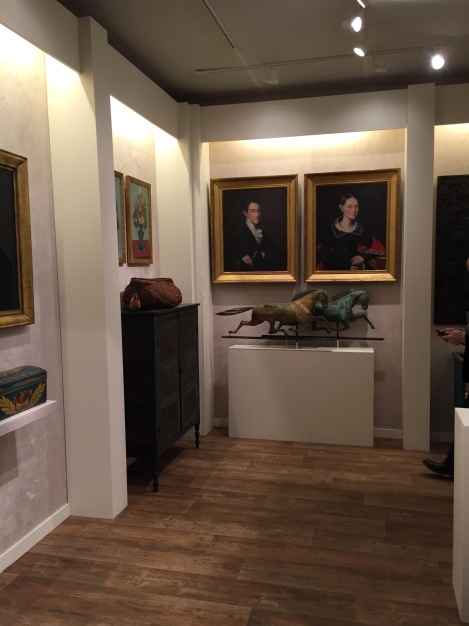Mahogany dressers. Bronze horses. Gold plated frames.
As I was walking down the corridors at the Winter Antiques Show at the Park Armory in NYC, I was beginning to feel really out of place. Looking at the objects, my dominating thought was simply “Everything here is so old. What would anyone want with a wooden and glass display cabinet for tea cups? And that horse painting that feels actually stiffer than a Ken doll, who wants that? And, oh my, that chair that looks as comfortable as rocks? I started spiraling downwards. Luckily I soon stopped myself. Wait a minute, I would have not one hesitation in defending why something “old” like the Vatican collection should be valued and cherished all the same as more modern works, why can’t I apply the same thought to the works here? Maybe it was because I just moved to New York where everything is fast and shiny, or maybe because I had just come from NEW INC’s (quick side note: NEW INC is a museum led incubator associated with the New Museum in which they host artists and technologists to give them the space and resources to prototype cutting edge projects) Demo Day. Either way, I had to have an attitude adjustment. So I went back to the entrance and tried again. I started to eavesdrop on a few conversations, “If it’s not the best, it’s not a thing at all”, “This one here is relatively affordable, you know, all things considered”, “Here you can see a real testament to the times.” It was that last comment that struck a chord with me. Other than thinking about the market value of these works, it was their connection to a specific time that really gave them their value. And, yes they were objects, furniture, antiques, but they are the very objects that prove how we humans related to our space, with what things we wanted to surround ourselves aesthetically, where we put our priorities.


I kept walking with these new thoughts in mind and turned a corner. I felt like I leapt forward a few centuries. White plates hung on the wall with a gold, white and blue overlapping design. Minimalistic, and striking. Large, yet subtle. Elegant and edgy. Not exactly like those wooden cabinets to say the least. But again, it was another marker of a way we like to transform our space. It is a reflection of us.
 To tie everything up in a nice little bow, I reached the final show booth which displayed contemporary photography miniatures alongside traditional miniatures done in oil paint. The contemporary miniatures took all of its cues from the traditional ones: harsh lighting, profile view, stiff gestures, simple clothing, no backgrounds, and bland expressions. These guys were downright eerie. But I couldn’t figure out why. They were exactly the same as the traditional ones, just done in a different medium, and made at a different time. That. It was the fact that they didn’t come from their own period. They were not born from a social matrix that was relevant to them. They were replicas of something that was, and thus inevitably when completed, were out of place. And there I had it: all this old stuff was important because it could never have been created in today’s age, because it is its age. We need all this old stuff to learn. No replica will ever do, will ever capture what was. Only what was can tell us all the nuance of, well, what was.
To tie everything up in a nice little bow, I reached the final show booth which displayed contemporary photography miniatures alongside traditional miniatures done in oil paint. The contemporary miniatures took all of its cues from the traditional ones: harsh lighting, profile view, stiff gestures, simple clothing, no backgrounds, and bland expressions. These guys were downright eerie. But I couldn’t figure out why. They were exactly the same as the traditional ones, just done in a different medium, and made at a different time. That. It was the fact that they didn’t come from their own period. They were not born from a social matrix that was relevant to them. They were replicas of something that was, and thus inevitably when completed, were out of place. And there I had it: all this old stuff was important because it could never have been created in today’s age, because it is its age. We need all this old stuff to learn. No replica will ever do, will ever capture what was. Only what was can tell us all the nuance of, well, what was.

